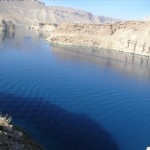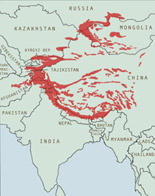The status and habitat of snow leopards in Afghanistan
Afghanistan’s snow leopard numbers are at best just estimates. After many years of war when no information was collected, it is almost a guess as to the numbers. Exact numbers are difficult to estimate but research suggests between 100 to 200 snow leopards in the country.
Snow leopard habitat in Afghanistan is in the Badakhshan Province in the north-east. Most recent information comes from Wakhan District of Badakhshan where since 2009 the National Environmental protection Agency and Wildlife Conservation Society (WCS) have installed remote camera traps and recorded over 1300 images of cats at 20 locations. In 2012 three snow leopards were captured and equipped with satellite collars. In part due to confirmed presence of the endangered species the whole of Wakhan District was declared a National park in April 2014 with an area of more than 10,000 square kilometres.
Threats to snow leopards in Afghanistan
The Snow Leopard Network’s 2014 report, Snow Leopard Survival Strategy identified the following threats as High Threats in Afghanistan.
- Habitat Degradation
- Prey Reduction due to Competition with Livestock
- Prey Reduction due to Legal Hunting
- Lack of Appropriate Policy
- Lack of Effective Enforcement
- Lack of Institutional Capacity
- Lack of Awareness Among Policy Makers
- Poaching by Military Personnel
- Growing Livestock Populations and Intensifying Human- Wildlife Conflict
Snow leopard conservation projects in Afghanistan
Afghanistan is a partner in the world’s first joint initiative which is uniting all 12 range country governments, nongovernmental and inter-governmental organisations, local communities, and the private sector around snow leopard conservation.
The Global Snow Leopard and Ecosystem Protection Program (GSLEP) focuses on the endangered snow leopard while conserving valuable high mountain ecosystems.
National Environment Protection Agency (NEPA) and Wildlife Conservation Society
In June 2009 Afghanistan’s National Environment Protection Agency (NEPA), in an effort to safeguard its natural heritage, released the country’s first-ever list of protected species now banned from hunting or harvest. This list includes the rare snow leopard which along with other wildlife has been devastated by more than 30 years of conflict. NEPA is working with the Wildlife Conservation Society, the Ministry of Agriculture, Irrigation and Livestock, and Kabul University.
Even during times of war in Afghanistan snow leopard numbers are decreasing due to excessive hunting, loss of key habitat and illegal trade. There have been snow leopard pelts for sale in tourist shops in Kabul, the capital, sometimes purchased by foreigners ignorant of the law. Local people can earn as much as $US1,500 per pelt. It is hoped now that the snow leopard is protected under Afghan law, it will be illegal for Afghan nationals or internationals to hunt or trade the species within Afghanistan. If the law is able to be enforced this will go a long way to helping the remaining few hundred snow leopards in this country survive.
In May 2009 Afghanistan announced the creation of its first national park: Band-e-Amir, a spectacular series of six deep blue lakes separated by natural dams made of travertine, a mineral deposit.
The Wildlife Conservation Society (US) is currently the only organisation doing scientific conservation studies in Afghanistan and will continue to work with the Afghan government to establish parks and protected areas.
Read more stories about snow leopards in Afghanistan.




